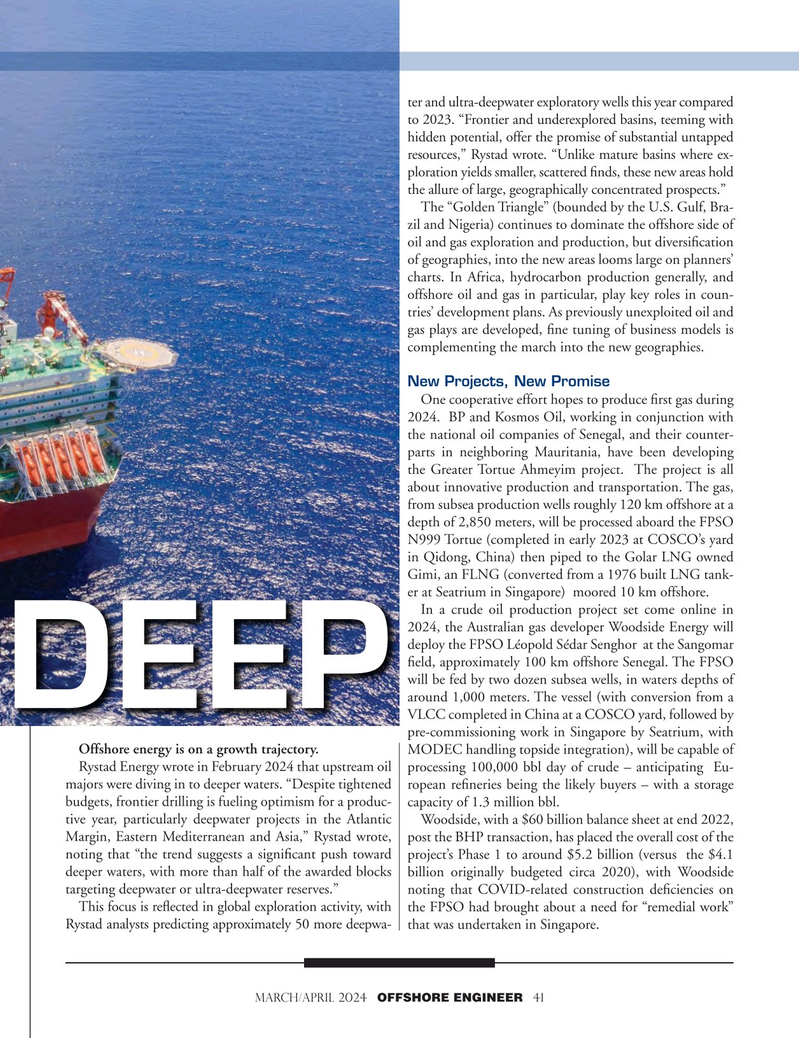
Page 41: of Offshore Engineer Magazine (Mar/Apr 2024)
Read this page in Pdf, Flash or Html5 edition of Mar/Apr 2024 Offshore Engineer Magazine
ter and ultra-deepwater exploratory wells this year compared to 2023. “Frontier and underexplored basins, teeming with hidden potential, offer the promise of substantial untapped resources,” Rystad wrote. “Unlike mature basins where ex- ploration yields smaller, scattered fnds, these new areas hold the allure of large, geographically concentrated prospects.”
The “Golden Triangle” (bounded by the U.S. Gulf, Bra- zil and Nigeria) continues to dominate the offshore side of oil and gas exploration and production, but diversifcation of geographies, into the new areas looms large on planners’ charts. In Africa, hydrocarbon production generally, and offshore oil and gas in particular, play key roles in coun- tries’ development plans. As previously unexploited oil and gas plays are developed, fne tuning of business models is complementing the march into the new geographies.
New Projects, New Promise
One cooperative effort hopes to produce frst gas during 2024. BP and Kosmos Oil, working in conjunction with the national oil companies of Senegal, and their counter- parts in neighboring Mauritania, have been developing the Greater Tortue Ahmeyim project. The project is all about innovative production and transportation. The gas, from subsea production wells roughly 120 km offshore at a depth of 2,850 meters, will be processed aboard the FPSO
N999 Tortue (completed in early 2023 at COSCO’s yard in Qidong, China) then piped to the Golar LNG owned
Gimi, an FLNG (converted from a 1976 built LNG tank- er at Seatrium in Singapore) moored 10 km offshore.
In a crude oil production project set come online in 2024, the Australian gas developer Woodside Energy will deploy the FPSO Léopold Sédar Senghor at the Sangomar feld, approximately 100 km offshore Senegal. The FPSO will be fed by two dozen subsea wells, in waters depths of around 1,000 meters. The vessel (with conversion from a
INTO THE DEEP
VLCC completed in China at a COSCO yard, followed by pre-commissioning work in Singapore by Seatrium, with
Offshore energy is on a growth trajectory. MODEC handling topside integration), will be capable of
Rystad Energy wrote in February 2024 that upstream oil processing 100,000 bbl day of crude – anticipating Eu- majors were diving in to deeper waters. “Despite tightened ropean refneries being the likely buyers – with a storage budgets, frontier drilling is fueling optimism for a produc- capacity of 1.3 million bbl. tive year, particularly deepwater projects in the Atlantic Woodside, with a $60 billion balance sheet at end 2022,
Margin, Eastern Mediterranean and Asia,” Rystad wrote, post the BHP transaction, has placed the overall cost of the noting that “the trend suggests a signifcant push toward project’s Phase 1 to around $5.2 billion (versus the $4.1 deeper waters, with more than half of the awarded blocks billion originally budgeted circa 2020), with Woodside targeting deepwater or ultra-deepwater reserves.” noting that COVID-related construction defciencies on
This focus is refected in global exploration activity, with the FPSO had brought about a need for “remedial work”
Rystad analysts predicting approximately 50 more deepwa- that was undertaken in Singapore.
MARCH/APRIL 2024 OFFSHORE ENGINEER 41

 40
40

 42
42